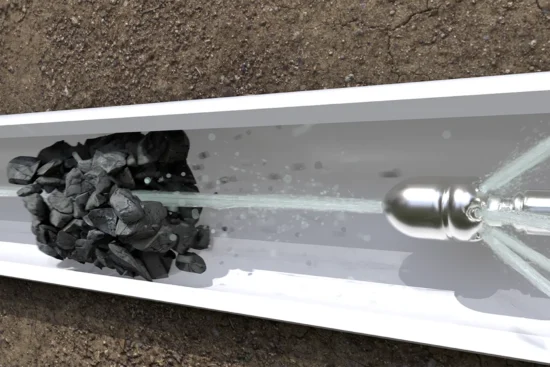Clogged drains are a common household nuisance that can lead to slow drainage, foul odors, and even major plumbing issues if left untreated. When faced with a stubborn blockage, you have two main professional solutions: hydro jetting and snaking. But which method is right for your situation? Let’s explore the differences, advantages, and best use cases for each.
What Is Drain Snaking?
Drain snaking, also called drain augering, is one of the oldest and most commonly used methods for clearing blockages in pipes. This method involves using a flexible metal cable with a corkscrew-like auger at the tip, which is inserted into the drain and rotated to break up or retrieve the clog.
Pros of Snaking:

✔ Effective for minor clogs: Great for simple blockages caused by hair, soap scum, or small debris.
✔ Less invasive: Snaking doesn’t put excessive pressure on your pipes, making it safer for older plumbing systems.
✔ Quick and cost-effective: A fast and budget-friendly option for homeowners.
✔ Ideal for localized clogs: Works well when the obstruction is near the drain opening.
Cons of Snaking:
✖ May not fully clear the pipe: Snaking punches a hole through the clog rather than completely removing buildup.
✖ Not effective for major blockages: Tough obstructions like grease buildup, invasive tree roots, or hardened sludge may remain.
✖ Recurring clogs possible: Since it doesn’t remove all residue from pipe walls, clogs may reappear over time.
What Is Hydro Jetting?
Hydro jetting is a more advanced and powerful drain-cleaning method that uses high-pressure water streams (typically 3,000 to 4,000 PSI) to blast away blockages, debris, and accumulated grease from the inner walls of your pipes. Plumbers use a specialized nozzle sprays water in multiple directions to ensure a thorough cleaning.
Pros of Hydro Jetting:
✔ Removes all buildup: Completely eliminates grease, sludge, tree roots, and mineral deposits.
✔ Long-lasting results: Because it thoroughly cleans pipe walls, it reduces the likelihood of future blockages.
✔ Eco-friendly: Uses only water—no harsh chemicals required.
✔ Works on tough clogs: Highly effective for commercial settings, restaurants, and homes with frequent drain issues.
✔ Prevents bacterial growth: Clears biofilm and bacteria that can contribute to foul odors and slow drainage.
Cons of Hydro Jetting:
✖ More expensive than snaking: Due to specialized equipment and expertise required.
✖ Not always safe for older pipes: High-pressure water can damage weakened or fragile plumbing systems.
✖ Requires professional assessment: A plumber must inspect the pipes first to ensure they can handle the pressure.
When to Choose Snaking vs. Hydro Jetting
| Issue | Snaking | Hydro Jetting |
|---|---|---|
| Minor clogs (hair, soap, food) | ✅ Yes | ❌ No need |
| Grease and sludge buildup | ❌ Not effective | ✅ Best choice |
| Tree root intrusions | ❌ May not work | ✅ Highly effective |
| Slow drains from residue | ❌ Partially clears | ✅ Fully clears |
| Fragile or old pipes | ✅ Safer choice | ❌ Risk of damage |
| Routine maintenance | ❌ Not thorough | ✅ Preventative cleaning |
Which Method Is Right for You?
- Choose Snaking if you have a simple clog that needs quick clearing, especially in older pipes that might not withstand high water pressure.
- Choose Hydro Jetting if you have frequent clogs, grease buildup, or want a more thorough and long-lasting cleaning solution.
Call Roto-Rooter for Expert Drain Cleaning Services
Whether your drain needs snaking or hydro jetting, Roto-Rooter’s professional plumbers have the expertise and equipment to diagnose and resolve any blockage efficiently. Contact us today to schedule a drain cleaning service and prevent future plumbing problems!